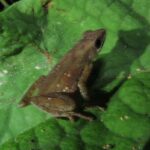- Unveiling the Intriguing Life of Ischnocnema garciai: The Tiny Guardian of Brazil's Atlantic Forest
- Taxonomy and Classification: A Look Within the Family Tree
- The Hidden World of <em>Ischnocnema garciai</em>: Natural Habitat
- Small Wonders: Physical Characteristics of <em>Ischnocnema garciai</em>
- Life Cycle and Behaviors: Beyond Tadpoles
- A Small Frog with Big Ecological Connections
- Facing the Storm: Threats, Conservation, and Future Prospects
- Cultural and Scientific Significance: Frogs as Symbols and Scientific Insight
- Conclusion: Preserving a Tiny Gem of Brazil’s Biodiversity
Unveiling the Intriguing Life of Ischnocnema garciai: The Tiny Guardian of Brazil’s Atlantic Forest#
Beneath the dense greenery of southeastern Brazil’s Atlantic Forest lies a charming yet elusive creature—Ischnocnema garciai, a tiny amphibian whose quiet existence serves as a barometer for this rich biome’s health. While many casual observers overlook frogs in favor of more flamboyant wildlife, Ischnocnema garciai enchants whoever delves deeper into its captivating and delicate world.
Despite its modest size and cryptic habits, Ischnocnema garciai harbors an exceptional quality: it bypasses the traditional tadpole phase entirely. This species develops fully within the egg capsule, emerging as a miniature frog, skipping the vulnerable aquatic larval stage completely. A biological marvel in its own right, this direct development strategy provides the tiny frog a unique advantage, enabling it to survive and thrive within its forest-floor domain.
Within this exploration, we journey through the intricate details of Ischnocnema garciai, celebrating its place in nature, uncovering its astonishing behaviors, and recognizing the urgent call to protect its fragile existence.
Taxonomy and Classification: A Look Within the Family Tree#
Ischnocnema garciai belongs to the family Brachycephalidae, a group renowned for their specialized reproductive strategies and unique physical adaptations. Until recently, researchers classified the genus Ischnocnema broadly within leptodactylid frogs; however, advances in molecular genetics and evolutionary studies provided clearer insights, allowing biologists to better understand relationships among amphibians. The genus Ischnocnema includes approximately 40 species notable for their direct developing reproductive mode and absence of free-swimming tadpoles.
First described in the latter half of the 20th century, Ischnocnema garciai was named in honor of the distinguished Brazilian zoologist, Paulo Garcia, whose extensive contributions to amphibian conservation and taxonomy have paved the way for emerging studies and awareness campaigns aimed at protecting Brazil’s extraordinary amphibian diversity.
The Hidden World of Ischnocnema garciai: Natural Habitat#
Deep within Brazil’s Atlantic Forest region, spanning primarily Minas Gerais and parts of Espírito Santo, the moist and temperate climate offers a perfect sanctuary to this diminutive creature. Forest floors, blanketed by rich layers of leaf litter and fallen vegetation, create microhabitats ideal for shelter, reproduction, and feeding. The species thrives in elevations ranging from approximately 500 to 1,500 meters above sea level, where constant humidity and temperate conditions ensure stable living spaces.
Within this lush and diverse ecosystem, thriving bromeliads, ferns, moss-covered rocks, and decaying logs provide an array of micro-niches. The microclimate beneath dense foliage is critical to the frog’s survival, regulating temperature and humidity, protecting delicate eggs from excessive dryness or predators. Thus, the health of the Atlantic Forest directly influences their survival, highlighting their role as indicators of ecosystem integrity.
Small Wonders: Physical Characteristics of Ischnocnema garciai#
Measuring only about 20 millimeters in length at maturity, Ischnocnema garciai may appear fragile and insignificant. Yet, upon closer observation, it reveals subtle elegance in adaptation. Its skin, cloaked in earth-toned browns, greens, and grays, displays mottled patterns ideal for camouflage among the leaf litter and humus-rich forest floor.
Their slightly transparent underbelly and muscular limbs are adaptations for enhanced escape tactics and agile movements. Large, expressive eyes, designed for precise nocturnal vision, dominate their heads, perfectly adapted to detect movement among shadows and subtle changes in their environment. Furthermore, the distinctive rough-textured skin, bearing numerous granular glands, helps manage moisture balance, essential in their humid yet occasionally unpredictable microhabitats.
Life Cycle and Behaviors: Beyond Tadpoles#
A Unique Reproductive Strategy#
Ischnocnema garciai astonishes biologists and naturalists with its uncommon reproductive strategy. Rather than depositing eggs in aquatic habitats, female frogs lay small clutches of eggs securely hidden beneath leaf litter, fallen logs, or within decomposing material. Remarkably, eggs hatch directly into miniature versions of adult frogs, completely bypassing the aquatic tadpole stage that is typical of most amphibians. This adaptation—known as direct development—is a remarkable feat of evolution, allowing the species to colonize habitats with no standing or free-flowing water.
Nocturnal Hunters in the Shadows#
The quiet twilight hours mark the awakening of this tiny predator. Emerging from the safety of hidden retreats, Ischnocnema garciai embarks on nightly hunts, preying upon minute invertebrates like ants, termites, beetles, flies, and arthropods active on the forest floor. Their exceptional agility allows them to spring swiftly and accurately upon their prey, guided by adept visual and acoustic senses finely-tuned for life in a shadowy world.
A Small Frog with Big Ecological Connections#
Every organism, no matter how humble, plays an essential role in maintaining biodiversity and ecological stability. As both predator and prey, Ischnocnema garciai occupies a critical niche within its biome. By preying on insects and arthropods, it regulates potential pest populations, indirectly maintaining plant health. Concurrently, it serves as a valuable food source for larger amphibians, reptiles, birds, and small mammals, completing a hungry chain of life that keeps ecosystems vibrant and dynamically balanced.
Their sensitivity to environmental changes further positions them as key bioindicators. Changes in their populations can reflect broader issues relating to habitat degradation, climate change, pollution, and general ecological health. Thus, protecting this species involves safeguarding broader biodiversity and ecosystem stability.
Facing the Storm: Threats, Conservation, and Future Prospects#
Habitat Loss and Fragmentation#
The Atlantic Forest is among the most threatened biomes worldwide. Urban expansion, agricultural encroachment, and logging have significantly fragmented and reduced these vitally important habitats. These disruptions impact amphibians, including Ischnocnema garciai, which relies on precise micro-environmental conditions to reproduce and survive.
Climate Change and Pollution#
Climate change poses an insidious threat, causing unpredictable shifts in rainfall patterns, humidity levels, and temperatures. Even slight deviations in forest floor microclimates could jeopardize critical reproductive cycles and egg development, impacting this direct developing species disproportionately. Additionally, pesticide runoff from agricultural fields and pollutants from urban development contaminate soils, threatening the fragile skin and respiratory surfaces of amphibians.
Current Conservation Efforts#
In recognition of the ongoing threats, conservationists, researchers, and local activists are rallying for habitat preservation and biodiversification initiatives. Protected areas, private reserves, and sustainable development guidelines are emerging. Conservation programs emphasize community education, highlighting the essential role frogs play in ecosystem health, aiming to foster grassroots engagement to protect these unique representatives of Brazil’s incredible biodiversity.
Cultural and Scientific Significance: Frogs as Symbols and Scientific Insight#
Although often overlooked, frogs have long held cultural significance within Brazil. Indigenous communities interpret frog calls to signal environmental cues—such as impending rain—demonstrating their deep ecological knowledge and interconnectedness with local biodiversity.
Furthermore, scientists worldwide highlight amphibians like Ischnocnema garciai as partners in ecological and evolutionary studies. Due to their specialized reproductive strategy and vulnerability to environmental changes, these frogs offer key insights into how forest ecosystems are responding to conservation pressures and global environmental shifts.
Conclusion: Preserving a Tiny Gem of Brazil’s Biodiversity#
Hidden amid leaves and shadows, Ischnocnema garciai quietly symbolizes both the miracles of adaptation and the vulnerabilities of an increasingly threatened world. Appreciating this tiny but mighty creature forces us to recognize our vital connection with living systems and underscores the urgency fueling conservation and awareness.
Each of us holds power to ensure that the calls of this remarkable frog continue echoing softly through Brazil’s Atlantic forests. Supporting community-level conservation efforts, spreading awareness of the importance of amphibians, and standing up for the preservation of habitats can transform a quiet frog’s gradual decline into a thriving story of hope for our planet’s rich biodiversity and well-being.







